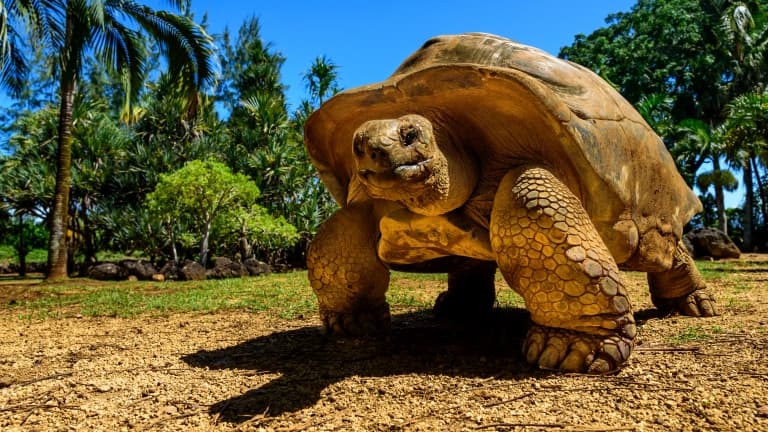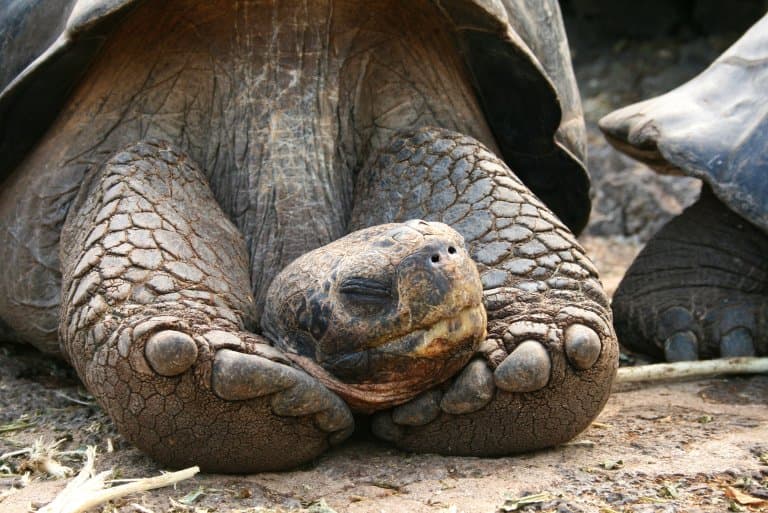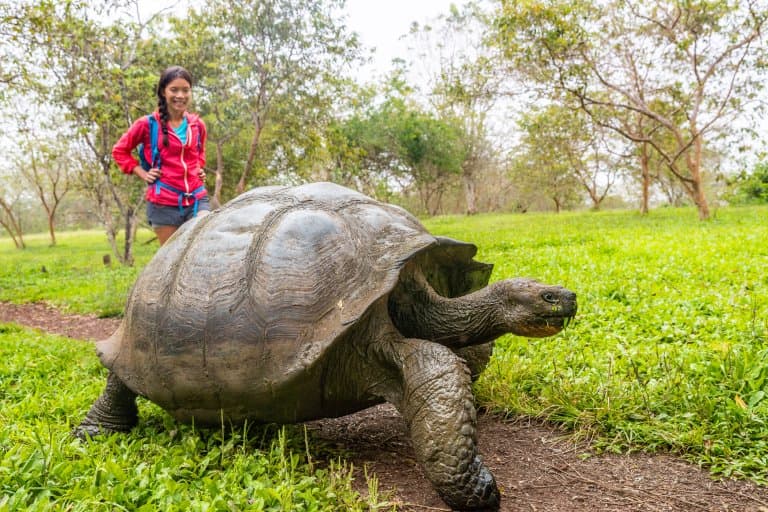Galápagos Tortoise Profile
The Galápagos giant tortoises are native to the Pacific island archipelago of the same name, and they are fascinating and ancient creatures.
They migrated from South America to the Galapagos Islands between two and three million years ago, probably during a large storm.
After migration occured, the species underwent diversification and split into around 15 subspecies, with different distribution and some differences in size and form.
These giant beasts are best known for the fact that they inspired Charles Darwin’s theory of evolution, after his legendary expedition in 1835.

Galápagos Tortoise Facts Overview
| Habitat: | Highlands, warm-hot, dry climate, vegetated areas, scrubland |
| Location: | Galapagos Islands |
| Lifespan: | Over 100 years |
| Size: | Up to 6.1 feet (1.87m) |
| Weight: | 135kg – 400kg (300lb – 880lb) |
| Color: | Mid-dark brown/greyish |
| Diet: | Vegetation – grasses, fruits, cacti |
| Predators: | Galapagos hawk, dogs, rats (during egg stage and infancy) |
| No of Species | 1 species, 13 subspecies |
| Conservation Status: | Vulnerable |
It is generally agreed that there are now 13 different living subspecies of giant tortoise, although some are so closely similar that it took some time to identify whether they were in fact separate species or not. At least 2 subspecies are now sadly extinct.
They are very large in size and the larger males can reach lengths of up to 6 feet from head to tail, 4 or 5 feet over the curvature of their shell, and a weight of up to 880lbs. The females of the species are generally smaller.
Galapagos tortoises have two main shell types: domed and saddle backed. The saddle-backed tortoises have saddle shaped shells with a high notch above the head, allowing their necks to reach up higher to eat vegetation off trees and bushes.
These are found in the drier and more arid of the islands, where there is less vegetation on the ground. The dome-shelled tortoises lack this notch, meaning their ability to lift their heads is restricted.
These species are found on the large and more humid islands, where there is lots of food to eat on the ground and more low-lying vegetation.
Breeding generally happens during the dry, hot season between January and May, although mating can happen at other times of the year.
Mating can last several hours, and the males make a roaring sound during the process. After mating, the females lay their eggs in nest holes on the ground, which they cover up and leave.
After an incubation period of 4 to 8 months, the baby tortoises hatch and burrow through the sand and soil to reach the surface. They are on their own from the beginning.
Interesting Galápagos Tortoise Facts
1. The Galapagos Islands were named after the tortoise
These giant tortoises were once so prevalent in the island archipelago off the coast of Ecuador, that the Spanish explorers there in the mid 1500’s named the islands for them – the name ‘Galapago’ means ‘tortoise’ in Spanish.
Charles Darwin noted with astonishment that each of the 13 larger islands in the Galapagos chain had its own slightly different breed of giant tortoise.
Each of the separate subspecies had adapted specifically for life on their own island – sparking his theory of evolution. 1

2. The death of one tortoise sparked a surge of global awareness
In 2012, Lonesome George – the last remaining survivor of his species, the Pinta tortoise – died on his home of Pinta Island. Living to over 100 years old, Lonesome George became a much-loved public figure, and his death was the catalyst for a worldwide concern over endangered species.
Repeated efforts were made to find George a mate, so as to continue his species.
Sadly, these efforts were in vain, and the Pinta tortoise is now extinct. 2
3. The Galapagos tortoise can live to 175 years old
The tortoise species is generally well known for old age, and the Galapagos tortoises are no exception, often reaching the impressive age of one hundred years and more.
In captivity, they can easily live to be up to 177 years old. One Galapagos giant tortoise living in captivity, Harriet, lived to be 175 years old. 3
The Galapagos tortoise came 10th on our longest living animals in the world list.
4. The Galapagos tortoise have a slow pace of life
Indeed, they can spend up to 16 hours of the day resting or sleeping; lying down to conserve energy.
The rest of their time is generally spent eating; however, they are able to go for many months at a time without food or water if necessary, because they can store food and water in their bodies. They enjoy bathing in water, although they do not swim.
They also walk extremely slowly, at the rate of around 0.16 miles per hour. 4

5. Galapagos tortoises and small birds have formed a symbiotic relationship
The Galapagos finch and other small birds are often seen sitting atop the giant tortoises’ backs.
The tortoises enjoy their small friends eating the ticks out of the folds of their leathery skin, while the birds enjoy an easy meal.
6. Galapagos tortoise eggs are the size of tennis balls
The clutches of eggs are laid inside holes in the ground which the mother digs out with her back feet.
The eggs are incubated by the sun and the baby tortoises are independent from hatching.
7. Only two tortoises of the Fernandina Island variety have ever been found
In 2019, researchers were excited to discover a lone female of the Fernandina tortoise, chelanoidis phantasticus, living on Fernandina Island.
The last and only other tortoise to be discovered on this, the most western of the Galapagos islands, was in 1906. 5
8. Galapagos tortoises’ shells are not solid
Although their huge shells look like a vast weight for the animals to carry, the shells are actually made up of honeycomb-like structures with air filled holes.
This means that the shells are not as heavy as they look, and allow the tortoises to move about without much difficulty.
The top part of the shell is called the carapace; the belly of the shell is known as the plastron.
9. The lungs of the tortoise are on their backs
They are situated just under the domed part of the shell. When a tortoise is startled or feels threatened, it will retreat inside its shell with a loud hissing sound.
This sound is the air releasing from their lungs as they squeeze inside their shells.
10. Galapagos tortoises will use height to settle a fight
When a fight breaks out between two males, they will face each other, glare into each other’s eyes and reach their heads higher and higher with their mouths wide open.
The winner of the fight is simply the one to raise his head the highest, and the loser will retreat with a hiss of air.
11. The Charles Darwin research station is helping tortoise populations
This research station, named after the evolutionary theorist, is based in the Galapagos islands themselves.
Staff at the station hatch and raise Galapagos tortoises from eggs in captivity, releasing them into the wild once they are old enough to resist the danger of predation from the Galapagos hawk.
12. Humans are the main threats to adult Galapagos tortoises
While the Galapagos hawk is a natural predator of the Galapagos tortoise during infancy, once the Galapagos tortoise reaches adulthood, there is really only one threat to their existence: humans.
Habitat destruction, hunting and poaching have been the main causes of the decline in population of these gentle giants.
A huge decline in the population of Galapagos tortoise was caused through their exploitation by whalers and fur traders, who discovered that these giant tortoises could live for months on their ships without food or water – an endless supply of onboard fresh meat. They were also hunted for their oil which could be used in lamps.
This exploitation is estimated to have caused the loss of up to 200,000 Galapagos tortoises. It is believed that population levels originally peaked at around 250,000, but current estimates are sadly much lower at around 15,000 in the wild. 6

Galápagos Tortoise Fact-File Summary
Scientific Classification
| Kingdom: | Animalia |
| Phylum: | Chordata |
| Class: | Reptilia |
| Order: | Testudines |
| Family: | Testudinidae |
| Genus: | Chelonoidis |
| Species Name: |
Chelonoidis Niger |
Fact Sources & References
- “Galápagos tortoises”, National Geographic.
- “Galápagos Tortoise”, San Diego Zoo & Wildlife Alliance.
- BBC (2006), “Harriet the Tortoise dies at 175“, BBC News.
- “Giant Tortoise”, World Wild Life.
- Corryn Wetzel (2022), “Galapagos tortoise thought extinct for 100 years has been found alive”, New Scientist.
- “Galapagos Giant Tortoise Conservation”, Galapagos Conservation Trust.
